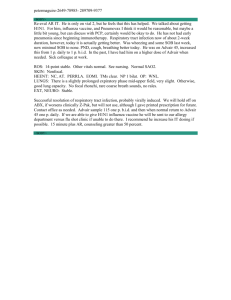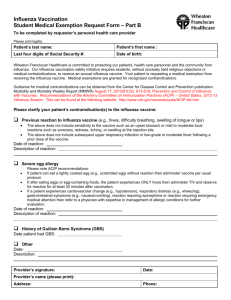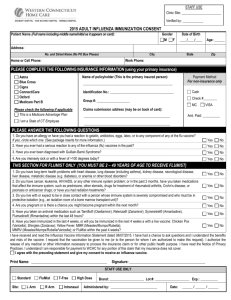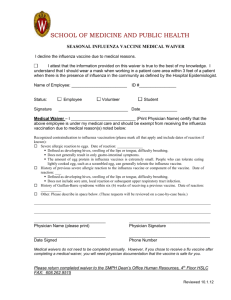2009 H1N1 Influenza Response in China
advertisement
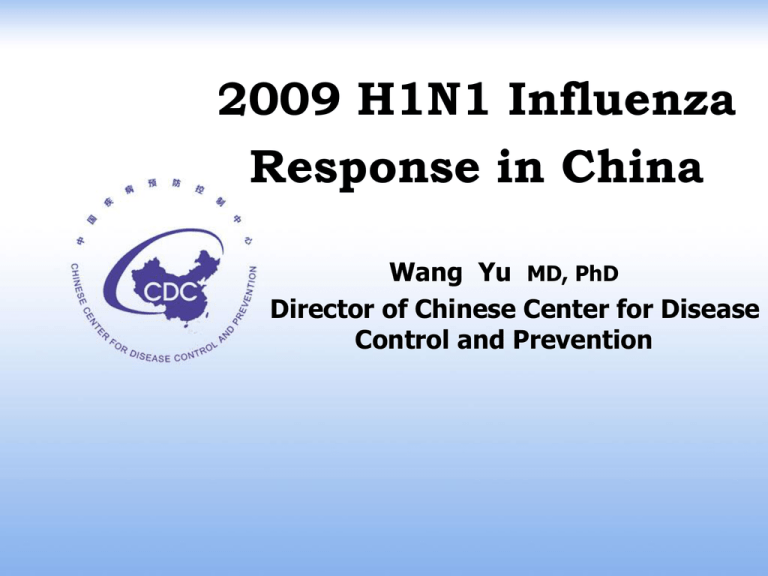
2009 H1N1 Influenza Response in China Wang Yu MD, PhD Director of Chinese Center for Disease Control and Prevention 1 Current situation in China Spreading of Pan(H1N1) influenza in mainland China As of June 30, N=131 As of Oct. 25, N=1522 As of July 31, N=246 As of Sep. 6, N=440 School outbreaks of pan(H1N1) 2009 influenza by county, China (May 30-Oct.25) 612 Counties reported pandemic (H1N1) 2009 influenza school outbreaks. Epi-Curve of pan(H1N1) 2009 Influenza outbreaks in schools, China (May 30-Oct.25) 6 2007—2008 2008—2009 2009—2010 12 5 3 6 ILI% ILI% 2009—2010 8 2 4 1 2 0 0 14 17 20 23 26 29 32 35 38 41 44 47 50 1 WEEK 4 7 10 13 14 17 20 23 26 29 32 35 38 41 44 47 50 1 2007—2008 2008—2009 4 7 10 13 WEEK Percentage of ILI internal outpatient visits reported by sentinel hospitals in Southern China 2009—2010 9 Percentage of ILI paediatric outpatient visits reported by sentinel hospitals in southern China 14 2007—2008 2008—2009 2009—2010 12 8 10 7 8 6 5 ILI% ILI% 2008—2009 10 4 10 2007—2008 4 6 4 3 2 2 1 0 0 14 17 20 23 26 29 32 35 38 41 44 47 50 1 4 7 10 13 WEEK Percentage of ILI internal outpatient visits reported by sentinel hospitals in northern China 14 17 20 23 26 29 32 35 38 41 44 47 50 1 4 7 10 13 WEEK Percentage of ILI paediatric outpatient visits reported by sentinel hospitals in Northern China 45 Untyped Yamagata Victoria B(lineage not determined) A(unsubtyped) A(unsubtyped excluded H1N1pdm) H1 H3 H1N1pdm Positive(%) 2500 2000 1500 40 35 30 25 20 1000 15 Percent positive Number of Positive 3000 10 500 5 0 0 14 16 18 20 22 24 26 28 30 32 34 36 38 40 42 44 46 48 50 52 Week Percent of Specimens Positive for Influenza Reported by Influenza Lab Network: Novel Influenza A(H1N1) vs. Seasonal Influenza by Week, southern China, 2009 Untyped Yamagata Victoria B(lineage not determined) A(unsubtyped) A(unsubtyped excluded H1N1pdm) H1 H3 H1N1pdm Positive(%) Number of Positive 1400 1200 1000 800 600 45 40 35 30 25 20 15 400 10 200 5 0 Percent positive 1600 0 14 16 18 20 22 24 26 28 30 32 34 36 38 40 42 44 46 48 50 52 Week Percent of Specimens Positive for Influenza Reported by Influenza Lab Network: Novel Influenza A(H1N1) vs. Seasonal Influenza by Week, Northern China, 2009 Number of reported case, by age and sex Reported Cases 20000 18000 Male 16000 Female 14000 12000 10000 8000 6000 4000 2000 0 0~ 10~ 20~ 30~ 40~ 50~ 60~ Age group (years) Reported severe case and death by onset time 5 4 60 Severe cases Conformed desths 50 3 30 2 20 1 0 10 Date of illness onset 0 Cumulative cases 40 8/3 8/6 8/9 8/12 8/15 8/18 8/21 8/24 8/27 8/30 9/2 9/5 9/8 9/11 9/14 9/17 9/20 9/23 9/26 9/29 10/2 10/5 10/8 10/11 10/14 10/17 10/20 10/23 Cases Cumulative cases(Semi-logarithmic line chart) Characteristic of severe ill cases (As of Oct. 25) • 49 severe ill cases (4 deaths included) • Gender: 31 male, 18 female • Median age: 19 yo ,range:7 mo-72 yo • Oseltamivir: 100%(7/7) • ICU: 22.7%(5/22) • Ventilator: 43.8%(14/39) • Underly condition: 54.5%(24/44) • Diabetes, COPD, Hypertension, Uraemia, TB, Hepatitis B, Heart disease • Complications : • pneumonia:81.8%(18/22) • Respiratory failure: 54.5%(12/22) Response to pandemic(H1N1) 2009 influenza Pandemic Trajectory I II III NORTHERN HEMISPHERE Mitigation Immunization SOUTHERN HEMISPHERE Spring Surveillance Summer Fall Quick Response • • • • • • • • • Government emergency response Border screening Expanding laboratory testing capacity (training) Enhancing surveillance Case isolation, close contact quarantine Anti-viral drug production and stockpiling Vaccine development and innoculaton Public health education and communication Timely technical guidelines updating according to the situation evolution • International cooperation, WHO, USCDC, eCDC National Joint Working Mechanism in Response to Pandemic(H1N1) 2009 Influenza in China Joint Working Mechanism Established on April 27, 2009 Expert Consultation Animal husbandry & Veterinary Science & Technology International Collaboration Communications Logistic support Medical Service Border Control Coordination 由卫生部牵头、中宣部、外交部、发改委、科技部、质检总局、农业部等33 个部门组成,分为8个组和1个专家委员会 Change of Response Strategies April 25-July 10 Containment of transmission caused by imported cases July 10 Mitigation of community-level spreading Preparation for winter season Border Entry Screening • As of August 23, 56 million travelers screened • 17,909 febrile patients found by fever screening • 757(4.2%) confirmed infection with novel H1N1 influenza Containment Stage Border entry screening (BES) Case isolation and contact quarantine Expanding surveillance system and laboratory diagnosis capacity Development of guidelines May 11, first H1N1 case of mainland China was confirmed by Sichuan province CDC. Case Isolation & Contact quarantine Case isolation Admitted to designated hospitals Strict isolation in single room Contact quarantine As of Aug10, tracing 9,938 close contacts quarantined at home or at designated hotels Among them , 551 (5.5%) confirmed infection with novel H1N1 influenza Expanding surveillance system and laboratory diagnosis capacity Diagnostic kit development, distribution and training Influenza laboratory network expanded to all prefecture CDCs Expand ILI sentinel hospital surveillance system Mandatory reporting requirement of novel H1N1 influenza case Expand ILI Surveillance Sentinel Hospitals and Influenza Lab Network •Laboratories: 63 •Laboratories: 411 •Sentinel Hospitals: 197 • Sentinel Hospitals: 556 Before May, 2009 After June 2009 Epidemic Curve of Pan(H1N1) Influenza Cases, China(As of Oct. 25, 2009, N= 44212 ) 10000 Suspected cases Clinical diagnosis of cases 9000 Confirmed cases 8000 July 10---Aug. 31 Summer holidays Sep.1 Term began 7000 July 8, Adjustment of the measures for prevention and control Close contacts: Medical observation in home Mild cases: Isolation and treatment in home Reported cases 6000 5000 June 18, School outbreak 4000 3000 Sep 30,2nd version of surveillance protocol released Oct. 1st-8th, National Day vacation May 11, First imported case 2000 1000 0 17 18 19 20 21 22 23 24 25 26 27 28 29 30 31 32 33 34 35 36 37 38 39 40 41 42 43 Week (date of illness onset) Note: April 27 (Monday of Week 17), Oct. 25 (Sunday of Week 42) Mitigation stage • Change case reporting requirement • Mass campaign of health education focusing personal hygiene and community prevention • Control and management of school outbreak Case reporting requirement Emphasizing severe ill case and death Laboratory diagnosis focus on severe ill cases cases with underlying medical condition Outbreak confirmation Vaccine and immunization Clinical trial conducted by China CDC 10 candidate vaccines 3 formulas of vaccines: adjuvant whole virus inactivated vaccine , unadjuvant whole virus inactivated vaccine, unadjuvant split virus vaccine 13,800 subjects and 4 age groups 3 -11years, 12-17years, 18-60years and >60years study design: randomized, double-blinded and controlled Intervention: two IM dose novel H1N1 separated by 21 days 7.5 mcg, 15mcg and 30mcg Field studies launched on July and completed by 26, August SFDA conferred licenses to 10 domestic manufactures on September 14 Unadjuvant split virus vaccine One dose for > 3 years old population Timeline of novel H1N1 flu vaccine R&D and immunization 22-26 Jul 27 Jul-11 Aug 16 Aug 17-20 21 22-23 24-26 Aug Aug Aug Aug 27-29 Aug 30 Aug13 Sep 14 Sep 15-17 Sep 18-22 Sep 21 Sep - inoculate first dose and collect blood speciman on day 0 inoculate second dose and collect blood speciman on day 21 tes the blood sample Uncode and primary data report the first stage of clinical trial and medium-term data report,submit the application to SFDA register for approval and examine vaccine's introduction and label print labels,subpackage,label the products approval storage delivery Prepare vaccination Initiate vaccination in Beijing H1N1 vaccine clinical trials of 10 manufactories 天坛生物–广西 科兴 –北京 华兰 –江苏 上海生物 –湖南 兰州生物 –内蒙古 长春生物-江苏 长春长生 –广西 雅利峰-河南 天元-河北 延申-河南 中 国 疾 病 预 防 控 制 中 心 CHINESE CENTER FOR DISEASE CONTROL AND PREVENTION Safety Result-AEs Occurrence rate by Vaccine Type Company A Vaccine Type No. I Rate(%) II III IV Total Without Adjuvant 15μg 440 10.7 0.7 0.0 0.0 11.4 Without Adjuvant 30μg 440 14.1 1.1 0.7 0.0 15.9 with Adjuvant 15μg 440 9.1 0.7 0.0 0.0 9.8 With Adjuvant 30μg 330 9.1 0.3 0.0 0.0 9.4 With Adjuvant 7.5μg 440 8.6 0.5 0.0 0.0 9.1 2200 9.9 0.6 0.1 0.0 10.6 Total Local reactions: Pain, Swelling, Induration, Rash, Itching Systemic reactions: Fever, Fatigue, Muscle Pain, Diarrhea, Allergy, Headache Immunogenicity by Age, without Adjuvant-15ug 100 90 80 70 60 50 40 30 20 10 0 200 160 % 120 80 40 0 A(3-11y) B(3-11y) Seroprection A(12-17y) Seroconversion B(12-17y) GMT Ratio Antiviral drug • Emergency authorization on Oseltamivir production for domestic manufacture • Increasing production • National stockpile and deployment - 1.3 million of treatment doses by 30 Sep. 2009 - Second Lot. by November • Priority of antiviral drug treatment • severe ill cases • cases with underlying medical conditions Health education campaign for personal hygiene and community prevention • Core information delivered • Hand washing • respiratory etiquette • stay home when sick with flu-like illness Control and management of school outbreaks Promoting hand hygiene and respiratory etiquette Morning fever screening Stay home when sick with flu-like illness Separate students with ARI and ILI from the healthy School closure and class dismissal Preparing for fall/winter season Preparing for winter season Enhance surveillance Vaccine production and innoculaton Antiviral drug stockpiling and distribution Medical service preparedness Monitoring of medical care burden and guidance for social distancing measures Public communication and advice Enhance surveillance Strengthen situation analysis and awareness Establish severe acute respiratory infection (sARI) surveillance in selected sentinel hospitals Analysis of hospital mortality reporting Vaccine and immunization •Results and conclusions of clinical evaluation: •All vaccine formulations were well tolerated without immediate serious adverse events. •Seroconversion rate and protective rate was >85% among both 15µg and 30µg group without adjuvant •1 dose spilit-virion vaccine without adjuvant had better immunogenicity than vaccine with adjuvant •Adolescent and adult had better response than children and elder •The AEs occurrence rate similar as seasonal influenza vaccine •Considering safety, immunogenicity and cost, 15µg split vaccine without adjuvant could be used for future vaccination Vaccine and immunization Vaccine production and distribution As of Oct. 21, 20 millions doses distributed and 222 thousands of persons vaccinated 100 million doses of vaccine expected to be produced by the end of first qua of year Priority of population groups: primary and middle school student health care workers and other essential service worker people with underlying medical condition Enhance surveillance of AEFI(adverse events following immunization ) Surge capacity of medical care Development of clinical management of severe ill case and patients triage guidelines Development of infection prevention and control guidelines Ventilator stockpile and increasing ICU capacity Physicians training Guidance for reduce surge burden on Local medical care No. of cases School closure Cancellation of mass gathering closure of restaurants and Local social entertainment venues distancing measure Suspension of commercial activities Surge capacity Current healthcare capacity Threshold No. of days Communication and advice service Continued mass campaign of health education to promote personal respiratory hygiene and prevention Main topic of public communication • Rationale of vaccination priority group policy • Vaccine safety concern • Mild case “self-isolation” and home care • Dealing with stress and anxiety for increasing of severe case and death Public communication and advice Challenges • Huge population vs. limited resources • Uneven development between eastern and western areas. Thanks


